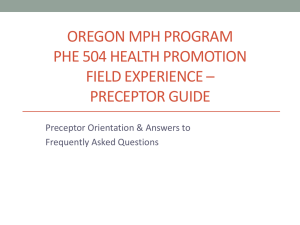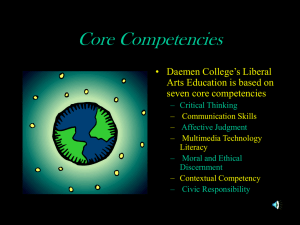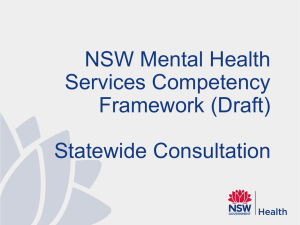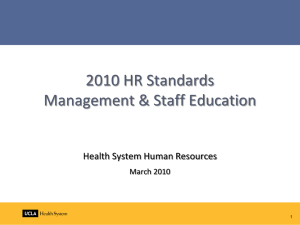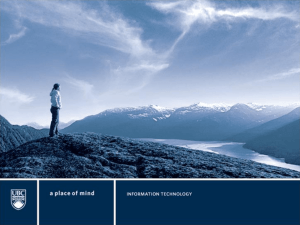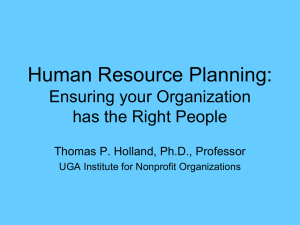bfdgd - Portland State University
advertisement
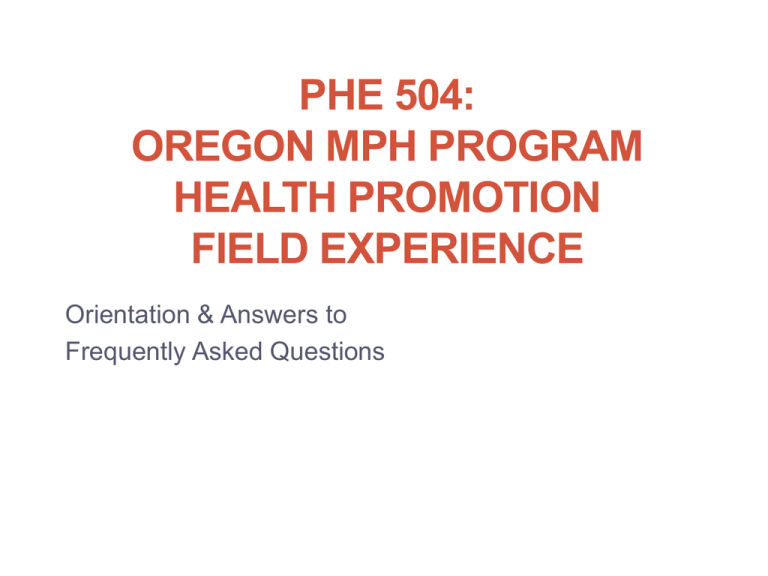
PHE 504: OREGON MPH PROGRAM HEALTH PROMOTION FIELD EXPERIENCE Orientation & Answers to Frequently Asked Questions What is the purpose of the Field Experience? • To demonstrate and apply knowledge and skills gained in a real-world setting • To integrate theory and practice in a supervised, applied setting • Socialization into the field of public health • To reflect on your learning competencies in the context of your field experience What is PHE 504? • “Field experience” vs. “Internship” • A culminating experience for students in the OMPH Health Promotion track • 6 credits total (200 hours), over 1 or 2* terms • TWO TERMS STRONGLY RECOMMENDED • *If over two terms, register for 3 & 3 credit hours; will be assigned “I” grade for first term until placement is complete • All core & track required classes must be completed before beginning your field experience • All students in the OMPH Health Promotion Track must register for PHE 504 with ‘Special Registration’ form What does the Field Experience involve? • Participation in a project addressing a public health issue, with guidance of preceptor • Applying classroom experience, knowledge, and skills • Daily journaling of work experience and reflections about the field experience • Bi-weekly communication with FE Coordinators • Completing a Final Summary Report, Evaluation, and providing examples of Products developed • Demonstrating measurable learning, track, and program competencies What are the Prerequisites? • Complete all core and track required courses • Meet with advisor to discuss interests and possible sites • Meet with FE Coordinators to discuss 1-2 weeks before submittal with the following • Field experience Position Description • Draft competency Matrix • Complete Application and Learning Contract form; provide copies of both forms for advisor and preceptor. Original signatures are required. • Develop measurable learning competencies addressing, at minimum, HP Competencies 1, 3, 4, 8, 9, and 10 • Note: Some sites may require background checks, vaccinations, and/or FE Agency Agreements How do I find a Field Placement? • Research, informational interviews, exploration • OMPH, PSUMPH, SCH listservs and websites • Personal contacts and connections • Faculty and advisory consultations • Discuss placement with other students and recent alumni Some variables to consider… • Issue interests • Professional goals • Skills to apply and competencies to meet • Work environment • Opportunity logistics • Other restrictions or needs • Qualifications of preceptor • Must work on site (cannot work at PSU or home) • Must not drive clients in personal car • No clinical activities • Places you may want to work someday, as well as at those you may not! What is the role of the Preceptor? • Helps shape and agrees to facilitate implementation of the Learning Contract • Supervises and guides the student through the Field Experience • Completes the Student Evaluation Form (provided, with due date, by student), and returns it to the FE Coordinator • Debriefs with faculty advisor or FE Coordinator regarding student’s performance, as necessary What are the minimum qualifications for Preceptors • Public health credentials, by virtue of training and/or experience, for purposes of mentoring and evaluating the student in the application of the public health skills and knowledge developed during the MPH degree program • Potential Preceptors will be evaluated on a case-by-case basis • Preceptors may not be OMPH faculty members or advisors, including at partner campuses. What are Preceptors looking for? • Preceptors commonly evaluate students on their demonstration of: • Confidence in communication and demonstration of skills • Initiative, and ability to ask questions • Working well both independently and as part of a team • Ability to achieve approved FE goals, finalize products, and meet all track compentencies Position Descriptions • The Field Experience Application and Learning Agreement packet must include a formal position description • Work with preceptor to develop a formal position description if one does not exist • Meet with FE Coordinator to review draft Position Description • Should include: • General description of project you will be joining • Placement responsibilities • Required Skills • Terms of placement (location, start/end dates, etc.) • Description of placement site Two Key Questions for Determining Suitability of Field Experience Site Is the project “public health” in nature, such that I will be able to apply public health tools and techniques to the issues I am to address? Is the Preceptor of a background that s/he can guide me in the specific application of the public health tools and techniques I have learned in this program? Where have students been placed? • State Public Health Division • County Health Departments • Other public agencies • Not-for-profit organizations • Condition-specific organizations • Population-specific organizations • Advocacy organizations • Insurance companies • School districts • Colleges/Universities …Etcetera… Please see list of previous Field Experience Sites in the FE Handbook What duties do FE students perform? • Community organizing • Project development and/or implementation • Evaluation • Report development and writing • Media work • Research • Volunteer training • Public education • Development of health promotion materials • Advocacy • Policy work …And much more! Why is the Learning Contract important? • Specifies learning competencies that determine the placement, and how they relate to track competencies (matrix) • Identifies activities and roles you will fulfill (position description) • Lists the products you will develop during your placement • Provides contact information about the site • Projects date of completion • Must be submitted by 5pm on Monday of the 5th week of the term => Note: this is a CONTRACT. Failure to satisfactorily complete what is specified in the contract will result in not passing the placement. What are the Health Promotion Track Competencies? 1. Apply theory in the development, implementation, 2. 3. 4. 5. 6. and evaluation of health promotion interventions, programs, and policies Develop interventions and programs to effect change at multiple levels, including individual, community, organization, and policy Design and implement strategies to promote health Solicit and integrate input from community and organization stakeholders Design and deliver health communication messages Evaluate and interpret results from program evaluations and other research What are the Health Promotion Track Competencies? (continued) 7. Define research problems, frame research questions, design research procedures, and outline methods of analysis 8. Apply ethical principles that govern the practice of public health 9. Enact cultural competency in diverse social and cultural communities 10.Develop a substantive Area of Emphasis How do I write Learning Competencies? Learning Competencies are brief (i.e., one sentence), specific statements of what a student will do. • “Who will do How Much of What by When.” • Describe the performance of a major cognitive skill • • • • • (knowledge, comprehension, application, analysis, synthesis, and evaluation) Pay particular attention to analysis, synthesis, and evaluation Begin with an “action verb” that matches the means of performance assessment Be explicitly measurable through at least three Learning Activities per Learning Competency Identify the intended outcome or product, not the process Reference and build upon the HP Track Competencies Learning Competencies vs. Learning Activities Learning Competencies and Learning Activities both • utilize brief (one sentence) and specific language • begins with an action verb to state what a student will do • must be reasonable in scope and breadth How are they different? Learning Competency • Describes a single, major cognitive skill • Links the Track Competency to at least 3 Learning Activities Learning Activity • Identify a specific action the student will take to show competency • Defined in an explicitly measurable way Note on Learning Competencies and Learning Activities • Plan for guidance and the possibility of revisions. Reviewing a draft of the matrix and job description with FE Coordinators by the 3rd week of the term • All Competency Matrices are different – what works for your colleagues may not apply for you • Do not copy, transpose, or otherwise base your competencies or contract on someone else’s. • Do develop your own specific, measurable, realistic, appropriate, and time-limited competencies based on the terms and deliverables of YOUR project. Competency Matrix Track Competency Actual Language for PSU HP Track Competency as found in handbook FE Learning Competency Your project/placementspecific competency(ies). One skill/theory per competency; may have several learning competencies per track competency. Learning Activities Minimum of three activities per competency. Note: Please number competency and number activities so that it is clear which activities are associated with which track competencies. Competency Writing Activity [AKA: what is wrong with this picture?] Track Competency 1. Apply theory in the development, implementation and evaluation of health promotion interventions, programs and policies. FE Learning Competency Use theory to develop evaluation tools for the Healthy Kids Learn Better Program. Learning Activities Competency Writing Activity Track Competency 3. Design and implement strategies to promote health. FE Learning Competency Design strategies to promote health among children in the Healthy Kids Learn Better Program. Learning Activities Competency Writing Activity Track Competency Enact cultural competency in diverse social and cultural communities. FE Learning Competency Respect different beliefs, cultures, values, economic and education levels throughout the community. Learning Activities Competency Writing Activity Track Competency Design and implement strategies to promote health. FE Learning Competency Develop a training manual for representatives of identified childcare organizations who will be trained on the Healthy Kids Learn Better Program. Learning Activities 1) Create training manual 2) Present to childcare organizations Competency Writing Activity Track Competency 3. Design and implement strategies to promote health. FE Learning Competency Design a mixed-methods outcome evaluation plan to assess effectiveness of the Healthy Kids Learn Better Program training manual. Learning Activities 1) Create evaluation plan with program coordinator. 2) Revise existing survey of training manual effectiveness to include new components of program. 3) Develop a focus group script to evaluate effectiveness of training manual. 4) Identify sampling scheme Theory Discussion Exercise • What do you do if the theory you are wanting to apply does not fit the specific FE Learning Competency you have developed? • What do you do if you cannot identify a theoretical basis for your project? • In what classes have you learned theory? • Remember: All placements must be theoretically grounded Ethical Practice and Cultural Competence Exercise • What would the practitioner need to be prepared to DO to ensure ethical behavior and/or culturally competent behavior with respect to the following? • Development of an informational brochure on diabetes management for Russian refugees and immigrants • Interviews about sexual health practices within the Latino population • Community meetings with female members of three Oregon communities around the topic of domestic violence Research Requirements • When is IRB required? • See Handbook, pg 9, #15 – What to do if my FE has a research component? • Try to avoid strict research experience that does not already have full IRB in place (we need memo w/ agency IRB info) • In evaluations or program development, as long as only used internally, a memo from preceptor may suffice (see sidebar in handbook) • The following will trigger questions from FE Coordinators and Human Subjects Research Review Committee (HSRRC): • High Risk Groups • Interviewing • Collecting Surveys Are Field Experiences paid positions? • Not usually but can be paid • Paid position may be negotiated between Preceptor and student • University is not involved in arrangements What is the Field Experience Agreement? (usually not required by agency) • A signed interagency agreement between PSU and field placement site • Delineates roles, responsibilities, and institutional terms of placement • Not in handbook; will be provided by FE Coordinators • Tailored to each placement • If required for your placement, must be complete and on file prior to start date • Contact FE Coordinators to see if your placement requires this agreement. How do I register for PHE 504? • Different than registering for other classes • Application and Learning Contract is signed by student, preceptor, and faculty advisor & approved by FE Coordinator • Field Experience Agreement (if required) is signed by site agency, faculty advisor, and PSU • Copies of both the completed Application and Learning Contract and FE Agreement (if required) should be provided to preceptor and FE Coordinators • Student completes goldenrod colored Special Registration Form, available in SCH. Receives departmental stamp upon FE Coordinators approval • Manual registration; please allow a few extra days for processing Bi-weekly reports • Due starting at the end of week 2 of placement and every 2 weeks thereafter (even through term breaks) • Brief updates (less than 1 page, may be bullet points) • Sent via email to both FE Coordinators w/ Last Name and FE Update in subject • Can be text or attachments • Update on past two weeks (challenges, highlights, etc) • Plans for the next two weeks • Reports are one opportunity to problem-solve and specify issues that have surfaced during the course of the placement. • Always contact the FE Coordinators with problems requiring immediate attention and indicate immediate nature in subject line Changes to Competency Matrix • Bi-weekly reports provide the opportunity to identify challenges during the Field Experience • Often changes to FE Learning Competencies and Learning Activities are required • All proposed changes to matrix • must be submitted to FE Coordinators for approval using track changes • Send copy to Preceptor • Approval required BEFORE activity occurs • Students must fulfill all FE Learning Competencies as they relate to the required OMPH Track Competencies How do I complete the Field Experience? • Meet all of the measurable FE Learning Competencies that support OMPH Track Competencies • Student responsible for submitting 1 packet, in hardcopy by 5pm on Monday of the 9th week of the term in which the placement will be complete. Packet to include: • Updated FE Student Checklist Form (updated and signed by student) • Most recent approved Matrix • Summary Report • Evaluation Report (by student – see form on pg 19 of handbook) • Student Research and Service Questionnaire • Final Products (cleaned if needed for IRB) • Request that Preceptor complete the Student Evaluation Form and return it to FE Coordinators by email. • Form and due date (end of week 9) to be provided to preceptor by student. • Meet with advisor to debrief, as recommended What is the Purpose of a Field Experience Summary Report? To clearly demonstrate how your specific FE Learning Activities and Competencies are reflections of the required OMPH Track Competencies. This summary report should be a minimum of 10 pages, typed, single-spaced, and should contain the following information (see pg 17of Handbook): • Section I: Introduction • Overview of organization and of your position • Section II: Evaluation of Track & FE Learning Competencies • State each FE Learning Competency and Learning Activity exactly as in your matrix • Describe how you met and demonstrated mastery of each • Reflect with descriptions of challenges, things you would change, additional work you would pursue, etc • Section III: Reflections and Recommendations • Discuss your professional competency in relation to experience and matrix, career goals, and area of emphasis. What is the Purpose of a Field Experience Evaluation Report? • To reflect on the overall experience of the placement • To identify the challenges and successes of the experience • To provide ideas on how the field experience can be improved • To assist with future placement of students What is the Purpose of the Preceptor’s Student Evaluation form? • Allows the preceptor to comment on the student’s performance • Provides additional information to advisor and FE Coordinators regarding student performance • Starting in Fall 2014, will also help determine final grade • Provides useful process information for the faculty advisor as s/he places students in the future How is the PHE 504 grade determined? The Field Experience Final Package is reviewed by both your academic advisor and the FE Coordinators. • Pass: • Demonstrable accomplishment of ALL learning competencies • Preceptor’s Student Evaluation form submitted with favorable reviews • Required paperwork (including summary report, final products, FE checklist, evaluation form, updated matrix) complete and submitted • Not Passed: • Learning competencies not demonstrated • Required paperwork not complete and/or submitted • Poor preceptor Student Evaluation Establishing a placement, step-by-step • Step 1: Orientation • Step 2: Preliminary research • Step 3: Meet with Faculty Advisor • Step 4: Research potential sites • Step 5: Contact FE Site and begin draft Application • Step 6: Solicit Feedback on Application • Consult with Preceptor, Advisor • Communicate with FE Coordinator(s) about plans 1-2 weeks prior • Begin risk management (Human Subjects, international travel, immunizations, background checks) • Step 7: Signatures and Submittal of Application no later than the Monday of the 5th week of term prior to planned field work term,1 full term prior if international placement. • Revise as required by FE Coordinator • Step 8: Register for PHE 504, Start Experience Timeline Attend Orientation & download Handbook Application due (if international) Register for PHE 504 Application due (domestic) Preliminary research Approvals Received -2 terms -2 terms, 5 wks -1 term -1 term, 5 wks (Monday) Bi-weekly updates Wks 2,4,6,8 Start Placement Meet w/ FE Coordinator(s) to review draft project description and matrix (recommended) Report Due End Monday Week 9 Summary of paperwork to be completed Before placement • Application & Learning Contract • Graduate FE Student checklist (signed by student and advisor) • Application and Learning Contract • Current CV/Resume • Health Promotion Track Advising Sheet • Unofficial Transcript • Career Objectives • Courses Related to Experience • Position Description • Learning Competencies Matrix • Products List • Other risk management, travel, or IRB documentation (as required) Summary of paperwork to be completed During placement • Bi-weekly email communication with FE Coordinators, for duration of placement At conclusion of placement (in hardcopy) • Graduate Field Experience Student Checklist • Final approved Matrix • FE Summary Report • FE Evaluation Report (filled out by student) • Student Research and Service Questionnaire • Final products (cleaned) • Preceptor’s Student Evaluation Form To prepare in advance • Update your resume • Have career objectives in writing • Think about skills you would like to augment before graduating when selecting a field experience • Research possible FE sites Other processes • Human Subjects/IRB approval (if research placement) • International travel approval Further information • For more information, please refer to the Graduate Field Experience handbook at: http://www.pdx.edu/sch/graduate-field-experience • Questions? Liana Winett, DrPH Field Experience Coordinator lwinett@pdx.edu Chris de Venecia, M.A. Field Experience Assistant Coordinator cdev2@pdx.edu

